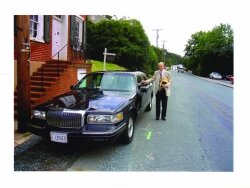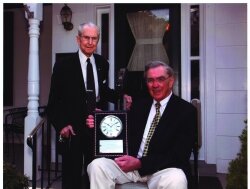103 strong: Scottsville's Thacker celebrates 103rd birthday
By Bill Tucker
Two hundred and sixty-seven years ago, before there was a Charlottesville or a Washington, DC, there was a Scottsville, Virginia. Through the years, the town has had more than its share of problems, but it has always bounced back, and one man has done more than his share to help.
His name is Raymon Thacker. He began on City Council in 1941 and served as mayor from 1966 to 1996. He celebrated his 103rd birthday on October 14.
Raymon is an unpretentious, mild-mannered gentleman whose quiet demeanor belies his drive and tenacity. Aside from being the owner of Thacker Funeral Home, Raymon has been a mover and a shaker of many of Scottsville’s organizations and improvements.
A good example is how Scottsville got the Uniroyal plant which, until its early 2010 shutdown, was a mainstay of the local economy.
In 1944, two men came to town looking for a location for a new plant to produce rayon for tires for the war effort, so Raymon, who was on City Council, showed them around. They found a location they liked that needed a railroad siding. Raymon got his friend, the railroad superintendent, to agree to put in a spur. The only problem was that the owner of the land would not sell. The men left and told Raymon to call them that night if the owner changed his mind. Later that afternoon, Raymon went back to try to persuade the owner to sell. He reminded the owner that these men were from the government’s Defense Plant Corporation. Raymon said the owner hemmed and hawed, but finally agreed to sell. Scottsville got the Uniroyal plant and 325 new jobs.
It took a little longer for Raymon to solve Scottsville's flood problems. Since 1870, Scottsville has had twenty floods of twenty feet or more. After Hurricane Agnes in 1972, a group started a movement to move downtown up the hill, away from the floods. Raymon contacted the Economic Development Authority, and then arranged for a feasibility study. The study came back with the levee idea along with a dam on Mink Creek. The request for $500,000 to build the dam was prepared, and Raymond again convinced an owner, Daniel Van Clief, to give the land needed for the proposed dam. Scottsville got the money, and the dam was completed in 1975.
But Raymon’s greatest achievement was the levee to hold back the James River. It took eighteen years of wrangling, arm-twisting, and many visits to Washington and Richmond. It involved the Army Corp of Engineers, HUD, Congressman J. Kenneth Robinson, Senator John Warner, and many others. Finally, with the recommendation from the Army Corp of Engineers, Congressman Robinson attached the loan request to an unrelated bill, and the House passed it, awarding Scottsville approximately $2.5 million. The A. Raymon Thacker Levee was dedicated on April 30, 1989.
It would be remiss not to mention some of his other civic contributions and achievements. He was instrumental in starting the Scottsville Lions Club, he brought about the building of a new bridge across the James in 1968, he worked on reviving the museum, serves as chairman of the Cemetery Association, was a member of the James River Basin Association, is a high ranking Shriner, and helped start the Scottsville Volunteer Fire Department.
One of his disappointments was that Piedmont Virginia Community College, which opened in 1972, was located in Charlottesville. (Having been on the committee from the beginning, he felt that the more central location for the five counties it serves should have been Scottsville.)
Raymon was also instrumental in getting Scottsville designated as a disaster area after Camille, the 1969 flood that devastated Central Virginia. However, because there were so many government agencies involved (HEW, HUD, OEP, Bureau of Public Roads, Corp of Engineers, etc.) it was difficult to know which to apply to or for what. Mayor Thacker testified before a Senate Subcommittee on Disaster Relief, telling the Senators as he is quoted in Torn Land, “Carefully cut out all the ands, ifs, and buts, so it would mean simply that everyone who honestly needs help would get it and that it be so clarified that even ignorant mayors like me could understand it.”
Raymon has seen and experienced many things in his life and can tell some fascinating stories. Once, when he was counseling a woman whose husband had died, she wanted to bury him in their front yard. Raymon convinced her to bury him in the cemetery. A year or two later, she came back and said she was Spanish and she would be buried in her family’s cemetery in Spain when she died. She wanted Raymon to dig up her husband and cremate him so she could take some of his ashes to Spain. Raymond went through the proper channels to exhume and cremate the body. Then there were some problems transporting the ashes. Raymon told her to take a bag on the plane and put some crackers on top of the ashes and if anyone asked, she should say she was having a snack. It worked.
Another story he likes to tell involves a poor man accused of stealing a ham. This man asked a prominent lawyer (for whom the man had worked) to represent him in the petty theft case. The lawyer asked him if he stole the ham, and he said, “Yes sir, I did.” The lawyer thought about it and said, “I want you to go home and cut that ham exactly in half and bring one half to me,” which the poor man did. In court, the lawyer told the judge, “Your honor, this man is innocent. He doesn’t have a bit more of that ham than I do.” The judge dismissed the case.
If you ask Raymon about his secret for longevity, his answer is simple. He believes his long life is a gift from God. Secondly, he mentions be his diet. He still weighs about 120 pounds. He eats a simple breakfast such as oatmeal, toast, and peach preserves, or two scrambled eggs with jelly or apple butter, and always one and a half cups of Maxwell House coffee (which he says is the best). Raymon seldom has lunch or snacks. Before dinner, he has about a jigger of Virginia Gentleman bourbon in a glass of Coca Cola and ice. For dinner, he says that his wife, Arbutus, a gourmet cook, might prepare something like chicken fettuccine. He does take a Centrum Silver multivitamin each day. He is still very mobile, drives and goes wherever he wants, and seems to have total recall for names, dates, and places.
When Raymon walks into Lumpkin’s Restaurant, everyone knows him. They come up and shake his hand, or wave, and some of the ladies give him a hug.
Raymon has known and met many interesting people. He remembers as a child listening to old Civil War veterans who sat around and talked about the war. One rode with Col. John Mosby (The Gray Ghost). Buck Langhorne, a colorful local character, was often visited by his sister, Nancy (Lady Astor). He remembers Jack Manahan, who owned a farm nearby, and his wife who claimed to be Anastasia (and some still think she was). He remembers the first cars, radio, television, electricity and indoor plumbing. He remembers telling John Kluge he should adopt Scottsville and do for it what Rockefeller did for Williamsburg. A few of the politicians he knew or knows are Colgate Darden, John Battle, Linwood Holton, George Allen, Mills Godwin, Doug Wilder, Chuck Robb, and Bill Tuck.
Raymon has a vivid memory of being in New York when World War II ended. He had been to a Funeral Directors Association meeting in Pennsylvania and afterwards traveled to New York with friends. They stayed at the Hotel Astor in Times Square. While there, President Truman announced the end of the war with Japan. Almost everything would be closed. They realized that soon there wouldn’t be enough whiskey, so they found a little liquor store nearby and they each made purchases. Raymon bought two bottles of Four Roses bourbon. On the way back to the hotel, they went by St. Patrick’s Cathedral. Raymon said he wasn’t going in because he wasn’t going to take whiskey into a church. One of his friends said he didn’t have a problem, so he took Raymon’s whiskey in. When they came out, soldiers and sailors were lined up along the street kissing all the girls. The following day, a fellow funeral director picked them up and took them to an afternoon of horse racing at Belmont. His costs for the three days, including getting a suit pressed, were $19.61.
By the way, Raymon still has one of the bottles of Four Roses, unopened. Happy 103, Raymon– we hope there will be many more.
~
Bill Tucker lives in Lynchburg. His last big story in the Hook profiled the late Jack & Anna Manahan.


2 comments
Happy Birthday!
No idea to what party affiliation Mr. Thacker belongs. But his tireless efforts brought the dike to the small town of Scottsville so all those fine folk could rebuild their business. With the government as a silent partner.